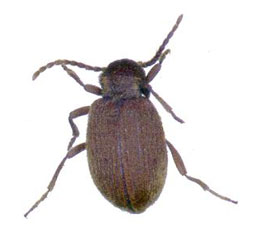 Spider beetles are small beetles belonging to the family Ptinidae. They are called spider beetles because they look somewhat like small spiders (or large mites) due to their long legs and relatively large, rounded abdomens.
Spider beetles are small beetles belonging to the family Ptinidae. They are called spider beetles because they look somewhat like small spiders (or large mites) due to their long legs and relatively large, rounded abdomens. Spider beetles are small beetles belonging to the family Ptinidae. They are called spider beetles because they look somewhat like small spiders (or large mites) due to their long legs and relatively large, rounded abdomens.
Spider beetles are small beetles belonging to the family Ptinidae. They are called spider beetles because they look somewhat like small spiders (or large mites) due to their long legs and relatively large, rounded abdomens.
Ptinids are not common pests but can become numerous in certain situations. They are general scavengers and can be found in pantries, museums, grain mills, warehouses, and attics that contain bird, rodent, or bat droppings.
The American spider beetle adult is from 1.5 to 3.5 millimeters in length and has a dark reddish-brown to black, shiny, globular abdomen. The head, thorax, legs, and antennae are covered with hairs that are a pale yellow to cream color.
The whitemarked spider beetle adult is from 2 to 4.3 millimeters long and are light brown in color with patches of white hairs on the wing covers. However, the white patches are frequently rubbed off of older beetles. Males have a thinner and more elongated abdomen than the females.
The shiny spider beetle adult (Fig. 1) is similar in shape and color to the American spider beetle. However, the head, thorax, legs, and antennae are the same color as the abdomen. This species, more than the other spider beetles, resembles a large, reddish mite.
The larvae of all three species are “C” shaped and cream colored with light brown heads. The length is dependent on the age of the larvae but can reach 3.5 to 4 millimeters
Spider Beetles can remain relatively active during freezing weather and are usually a stored product pest in the very northern states. They are scavengers that will feed on a wide variety of foods including grain products, seeds, dried fruits or meats, wool, hair, feathers, rodent and other animal droppings, and dried insects. These beetles survive best in old buildings and will often bore into old wood or cardboard boxes to pupate. Spider Beetle infestations are often difficult to control because they can live on such a wide variety of foods. Good sanitation is essential to reduce the number of areas where they may find harborage and develop. Often the source of a population will be found in a wall void, drop ceiling, or similar undisturbed area where food materials have collected. These sites should be cleaned and entrance to them sealed off if possible.